Tourism is one of the world’s fastest-growing industries, and ecotourism is one of its leading sectors. Ecotourism is growing by 10-15% every year (Matthews, 2002). Ecotourism is travel to natural areas that conserves the natural environment and helps the local people (Chin et al., 2000). Conservationists increasingly view it as a significant tool for protecting endangered species because it gives local people economic alternatives to resource exploitation, raises living standards, provides awareness and financial support for conservation, and finances protected areas (Nakamura and Nishida, 2009; Matthews, 2002; Ash, 2006; Wilkie & Carpenter, 1999). Although ecotourism enjoys broad support as a conservation tool, concerns have been raised that tourism can:
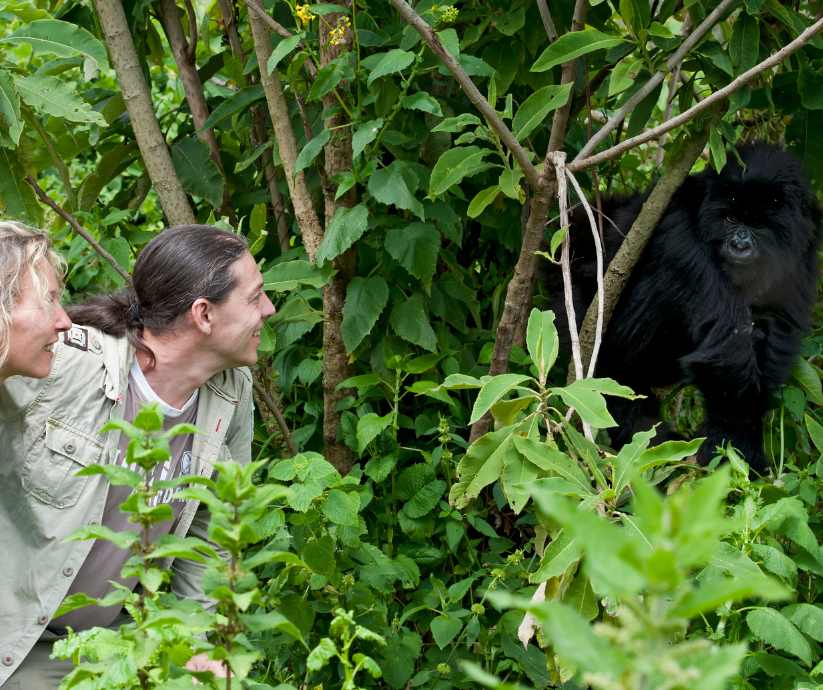
Ecotourism is an increasingly popular tool for protecting great apes, which are all either endangered or critically endangered in the wild (Beck et al., 2001, cited in Nakamura and Nishida, 2009). In Africa, ecotourism projects that habituate groups of wild gorillas and chimpanzees to human observers are thriving (Nakamura and Nishida, 2009). In Uganda, tourism has become the principal source of foreign exchange, and gorilla and chimpanzee viewing brings in 52% of tourism revenue (Wrangham, 2008, cited in Nakamura and Nishida, 2009).
In Indonesia and Malaysia, which are home to the only remaining populations of orangutans, ecotourism has taken a different approach. Unlike chimpanzees and gorillas who live in large social groups and spend a significant proportion of their time on the ground, orangutans are semi-solitary and almost strictly arboreal (Redmond, 2008; Galdikas, 1985). As a result, they're difficult to find and observe from the ground. Even when you can find them, tourists often claim that they're boring because of their slow activity patterns (personal observation). Orangutans in some areas spend 60.1% of their time foraging and eating and 18.2% resting (Galdikas, 1988). Instead, tourism most often revolves around ex-captive orangutans, which are often more social than those in the wild. They also spend more time on the ground and in association with conspecifics (Yeager, 1997; Snaith, 1999). As a result, they're often easier for tourists to see.
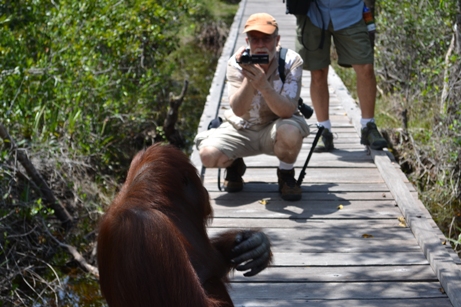
Tanjung Puting National Park is a 416,000 hectare park in the province of Central Kalimantan. The park hosts a wide variety of animals and plants, but it's most famous for its Bornean orangutans (Brend, 2006). The park was home to roughly 6,000 individuals in 2004, though there might be fewer living there now (Singleton et al., 2004). An orangutan rehabilitation program began there in 1971 in the area around the Camp Leakey study area (Galdikas, 1982). The program released 90 orangutans there between 1971 and 1985 (Galdikas and Ashbury, 2012), and possibly as many as 180 by 1994 (Yeager, 1997), when orangutan rehabilitation began moving to other areas. Today, tourists can visit ex-captive orangutans at three areas in the park: Camp Leakey, Tanjung Harapan, and Pondok Tanggui, where orangutans are given a daily supply of milk and fruit daily at a feeding and viewing platform (Brend, 2006; Galdikas and Ashbury, 2012). Although Tanjung Puting contains a large wild population and some wild individuals visit the feeding platforms, most tourists will only see ex-captive orangutans and their offspring (Ibid; personal observation).
Bukit Lawang is a former orangutan rehabilitation centre in the Gunung Leuser National Park in Sumatra, an 830,000-hectare park located in the Leuser Ecosystem (Dellatore, 2007; Singleton et al., 2004). Bukit Lawang acted as a rehabilitation project for Sumatran orangutans between 1972 and 1991. The project worked with 227 orangutans, though 51 are confirmed as having died (Dellatore, 2007). Orangutans are no longer rehabilitated at the centre, but the area remains home to a number of ex-captive orangutans and their offspring, who receive supplementary feedings of fruit and milk twice a day at a feeding platform attended by tourists (Ibid). Official Forestry Department figures show 206,963 foreign tourists visited Bukit Lawang between 1985 and 2003 for an average of 10,893 per year. Roughly 5,800 domestic tourists visited per year between 1990 and 2003 (Ibid). In total, 288,165 people visited this site over 18 years, though this might be less than half the real figure if unregistered visitors are taken into account (Rijksen & Meijaard, 1999, cited in Dellatore, 2007).
The ex-captive tourist sites in Tanjung Puting and Gunung Leuser remain controversial, and there are longstanding fears about the effects that such high densities of people have on the orangutans (Russon, 2009). In both national parks, tourists have been observed soliciting contact with orangutans, stroking them, trying to touch infants (leading to aggressive encounters with mothers), shaking trees to get an orangutan's attention, and taunting them with fruit (personal observation). Similar incidents have also occurred elsewhere. For example, at Sepilok in Malaysian Borneo, humans have been seen approaching ex-captive orangutans, offering them food, touching them, harassing them, and even hitting and kicking them (Bowden 1980, cited in Snaith, 2009). Three released orangutans in Tanjung Puting had to be recaptured and released into other areas after aggressive encounters with humans (Yeager, 1997).
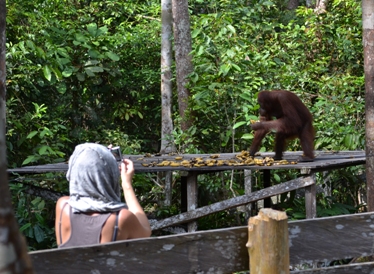
Close proximity between humans and orangutans at such tourist sites remains a concern. Because we are so closely related, pathogen exchange is a risk, and the great apes are particularly susceptible (Gillespie et al., 2008; Homsy, 1999). A number of cases of illnesses in apes have been linked to human respiratory viruses and bacteria, including influenza, measles, mumps, pneumococcal pneumonia, and herpes viruses (Ibid). In the Virunga volcanoes in Africa, over 81% of gorillas in seven groups used for research and tourism purposes suffered from an influenza-like disease, with six adults dying from it in 1988 alone (Reynolds, 2006, cited in Isabirye-Basuta & Lwanga, 2008).
Surveys at the Sepilok orangutan rehabilitation centre in Malaysia revealed that a significant number of tourists who visit the centre (which totalled 97,367 in 2006) are ill and potentially infectious at the time they visit. These visitors risk infecting the animals, local inhabitants of the area, and Sepilok rangers (Muehlenbein et al., 2010). These diseases not only pose a threat to the ex-captive orangutans, but also risk spreading to the wild populations, which would have no natural resistance. While some researchers argue that the largely solitary nature of wild orangutans will inhibit disease transmission, ex-captive orangutans at Tanjung Puting are social, often travel together, and have been observed soliciting play with wild females and their offspring and climbing in and out of their nests (Galdikas & Briggs, 1999). Ex-captives are undoubtedly exposed to human diseases, and respiratory diseases and skin infections have been transmitted between individuals (Yeager, 1997).
The risk of behavioural changes in wildlife also remains a concern at ecotourism sites. Bukit Lawang, Sepilok, and Tanjung Puting all report higher infant mortality for the offspring of ex-captives than for the offspring of wild orangutans (Dellatore et al., 2009; Russon, 2009). There have also bee cases of ex-captive females at Bukit Lawang cannibalising their offspring. This is a previously undocumented behaviour in wild orangutans. Researchers believe that stress caused by the high concentration of humans in the area might influence this behaviour (Dellatore et al., 2009).
Behaviour changes have also occurred at many other primate ecotourism sites. At Lamanai Archaeological Reserve in Belize, which attracted more than 20,000 visitors in 2000, a quarter of all tourists have observed other tourists or guides interacting with howler monkeys, including shaking branches, trying to make them roar, offering food, or making physical contact with them (Grossberg et al., 2003).
Provoking the animals disrupted their activity patterns, causing juveniles, females, and infants to move higher into the canopy. Adult and sub-adult males responded by roaring or approaching the humans, moving to the ground to bite people, or grabbing bags. Intense roaring against humans has also provoked neighbouring howler monkey groups to either roar back or approach (Ibid). Because howler monkeys are highly territorial and spend most of their time in the trees, roaring is believed to act as a spacing mechanism. Because competition between adult males is intense (Redmond, 2008; Di Fore & Campbell, 2007), this behaviour is a concern.
Instances of primates descending to the ground and biting or attacking humans have occurred at several primate ecotourism sites (Fuentes et al., 2007). They often involve offers of food, which can increase levels of aggression (Westin, 2007; Hsu et al., 2009). In India, local people and tourists give handouts to monkeys around Hindu temples, and the animals often become aggressive when food is denied, tearing clothes, biting, and raiding pantries and hotel rooms (Wolfe, 2002, cited in Westin, 2007). In Tanzania, vervet monkeys have been seen waiting at picnic tables and public toilets to ambush tourists to take their food (Ibid). At the Padangtegal Hindu temple on the Indonesian island of Bali, the strongest enticement for contact between tourists and the resident long-tailed macaques was the presence of food or the suggestion of it, in the form of plastic bags or items wrapped in banana leaves (Fuentes et al., 2007). Although there are signs warning tourists against feeding the animals, aggressive encounters are common, with 11.4% resulting in bites.
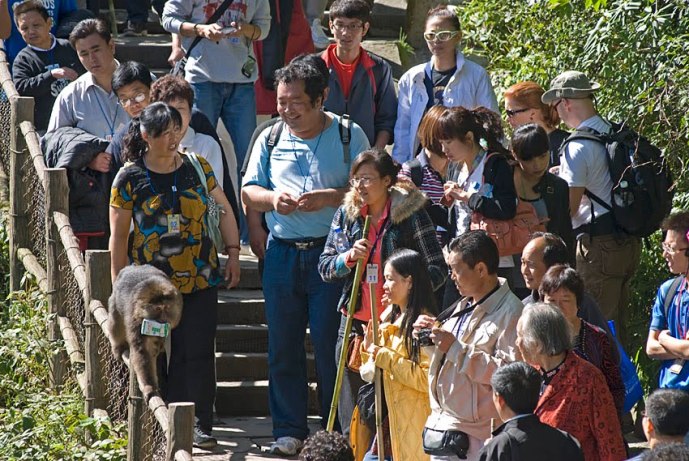
Macaques have the widest distribution of any nonhuman primate, and their home ranges frequently overlap with humans and tourist sites (Thierry, 2007; Fuentes, 2004). Conflict between humans and macaques often leads to injuries in both species. There's also a significant risk of disease transmission. Macaques can carry diseases that can transfer to humans, including simian foamy virus, herpes B, and simian retrovirus. In addition, humans carry influenza and respiratory pathogens that can spread to macaques (McCarthy et al., 2009).
Tourists can see wild Tibetan macaques at two sites in China: Mt. Emei and Mt. Huangshan. Observations at these sites show that humans initiate contact with macaques far more often than macaques do with humans, with pointing, waving, making facial threats, and slapping the railings the most common observed human behaviours (Ibid). Although humans and macaques provoke each other, the macaques repeated many of the human behaviours, indicating that tourists were deliberately antagonising macaques and waiting for a reaction (Ibid). The macaques at Mt. Emei regularly rob visitors of food and other possessions. Injuries are common, and 10 people even died over an eight-year period as a result of conflict encounters (Ibid). Such observations have also been seen at macaque tourist sites in Taiwan and Gibraltar, where humans initiate contact with the monkeys far more than macaques do with humans (Ibid; Hsu et al., 2009).
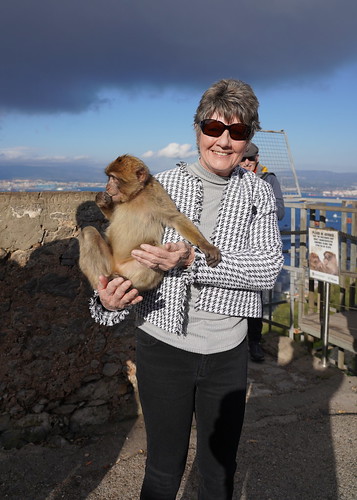
Increasingly habituated and bold primates can also create problems for local people. Monkeys used to tourists often seek contact with humans and raid crops and garbage bins (Muehlenbein et al., 2010). In Gibraltar, increased tourist activity around the resident Barbary macaques caused a rise in illegal feeding. Taxi drivers and tour guides encourage closer interactions between macaques and tourists, often so tourists could get better photos (Fuentes et al., 2007). Today, people in the tourist industry have a vested interest in conserving the macaques, but many residents in Gibraltar complain that they raid bins and occasionally kitchens looking for food, and have actively called for them to be removed and for some to be culled (Ibid).
Local people suffering as a result of conservation projects is not a new phenomenon. Developing national parks and protected areas has traditionally excluded local people from those areas, affecting their income and traditional subsistence methods and creating negative attitudes to conservation (Hartter & Goldman, 2010). Ecotourism aims to rectify this by bringing economic benefits to local communities.
The wild chimpanzees of Kibale National Park in Western Uganda attract tourists to one of the most densely populated areas in Sub-Saharan Africa (Hartter, 2009; Lepp, 2008; Lepp & Holland, 2006). There are 262 chimps per km2 on the west side of the park, and 335 chimps per km2 on the east side (Hartter, 2009). The predominant subsistence crops in the area are bananas, maize, beans, and cassava (Ibid).
Unfortunately, as much as 74% of local people have reported problems with wild animals raiding their crops and killing small livestock. While red-tail and vervet monkeys are the most common nuisance animal, other species of monkey and elephants also cause problems (Ibid).
A tourism project in the small, rural village of Bigodi (which borders the park) centres on an area of swampland which locals had always considered a nuisance, but offers visitors a perfect view of different species of monkeys and birds. It attracts about 75 tourists each month (Lepp, 2008).
Despite the high levels of poverty in the area and the need for income, residents were initially deeply anxious of allowing tourists into their community, and considered the project a plan by westerners to steal land and resources (Ibid). Although the residents have since warmed to tourism, conservation of the swamp has increased wildlife populations and crop raiding (Ibid). Although tourism has been successful and provides employment for young men, farming is still the principal subsistence strategy in the village. As a result, crop raiding not only threatens people’s subsistence and economic activities, but also affects education in the village because children have to miss school to guard crops (Ibid).
These findings aren't isolated. For example, more than a million people visit Costa Rica every year, and the tourism industry is heavily promoted. Nature tourism in the country is considered successful, but an examination of four tourist sites in Costa Rica found that, at two sites, developing infrastructure for tourism damaged vegetation, disturbed wildlife, and increased the risk of erosion. It also caused biodiversity loss and increased air pollution due to higher numbers of vehicles entering the area (Ibid). Community organisations diminished, alcohol and drug consumption increased, and crime increased in some areas (Ibid). However, tourism also brought more education, medical care, and female empowerment (Ibid). The economic improvements tourism can bring vary depending on who owns accommodation and services used and whether money stays in the area.
The examples shown in this article demonstrate some of the challenges and complexities inherent in tourism involving species that are often endangered and highly intelligent, opportunistic, and capable of aggression and live in areas of high human densities and low economic activity (Hadiswoyo, 2008). They are not, however, representative of all primate ecotourism projects.
Great ape ecotourism remains challenging. As Tanjung Puting and Bukit Lawang demonstrate, it's particularly difficult when the subject is an ex-captive. However, tourism with other great apes has had some notable successes. Tourism is regarded as one of the reasons why the number of mountain gorillas is increasing (Redmond, 2008). Gorilla trekking is the most popular activity for international tourists travelling to Rwanda, with more than 16,000 people travelling to the Virunga National Park in 2008 to see the gorillas (Spenceley et al., 2010). The tourism industry around this park in Rwanda brings in around $42.7 million through accommodation, tours, shopping, and other excursions, and the park itself directly employs at least 180 people (Ibid). The economic success of gorilla tourism have made protecting them economically important to the government and local businesses (Redmond, 2008). This attitude has also been seen in Tanjung Puting in Indonesia, which suffered widespread logging during the crisis that followed the resignation of General Soeharto in 1998. At its height, it is believed that up to 800 ramin wood logs were taken out of the park every day (EIA, 2003). The only part of the park that remained relatively undisturbed was the Camp Leakey study area--the principal tourist area in the park (OFI, 1999; G. Shapiro, personal communication).
The threat of disease transmission remains a concern in all areas where humans and non-human primates come into contact. In addition to habituated gorillas, chimpanzees living at the famous Gombe National Park in Tanzania are at risk of contracting tuberculosis from people, and have suffered in the past from polio and a respiratory disease that killed 11 chimpanzees (Wallis & Lee, 1999).
The risk goes both ways, with a female researcher in the Ivory Coast catching the Ebola virus from an infected chimpanzee in 1994 (Goldberg et al., 2007). While exposure at tourist sites is always a risk, it could be reduced by enforcing existing rules that govern primate viewing or by strengthening the unsatisfactory ones.
One expert recommends limiting the number of visits to gorillas; reducing the number of tourists per group; increasing the distance between humans and gorillas; enforcing rules on eating, litter, and faeces disposal; and stronger enforcement of rules that forbid tourists exhibiting illnesses from visiting the animals (Homsy, 1999).
Enforcing existing rules would also help mitigate aggressive encounters with monkeys. All reserves in Gibraltar that house macaques have signs stating that feeding them is illegal and punishable by a £500 fine, and warning humans of potential dangers (Fuentes et al., 2007). In Bali, while staff tentatively try to discourage contact between humans and macaques, they rarely intercede directly unless aggression occurs (Ibid). Singapore has an education and awareness programme in areas where humans and macaques come into contact, and sometimes enforces fines and penalties for people caught feeding them (McCarthy et al., 2009). Because interactions are more aggressive when food is involved, similar rules and enforcement should be developed at all ecotourism sites. Enforcing rules is often difficult for park rangers for cultural reasons and could possibly lead to arguments with tourists, but strongly-regulated tourist sites would likely decrease aggressive encounters and make primate viewing a much safer activity (personal observation). Some experts specifically recommend education and enforcement as ways to reduce human-howler monkey conflict in Belize (Grossberg et al., 2003).
The greatest success for ecotourism projects will likely come from involving local people. Conservationists are increasingly trying to ensure that local people benefit from wildlife tourism, but communities adjacent to protected areas still suffer from high levels of conflict and, particularly, crop raiding (Aharikundira & Tweheyo, 2011; Distefano, 2005). Bwindi National Park in Uganda has a large population of mountain gorillas and a lucrative tourism trade, but habituated gorillas regularly raid local farms (Aharikundira & Tweheyo, 2011). To mitigate this conflict, gorilla conservation organisations have organised special response units to help protect crops and limit retaliatory action. These projects have reduced raiding and attacks on humans and enjoy community support (Ibid). However, local people complain that park authorities are so focused on gorillas that they remain indifferent to crop damage by other animals, which is often more severe (Ibid).
Case studies show that primate tourism can often bring development that negatively impacts on the environment, and the influx of large amounts of people can change traditional behaviours, lead to crime and price increases, and exclude local people from areas they've traditionally used (Koens et al., 2009). However, they've also been shown to bring medical facilities, increased education, and help for the poor. For example, revenue from Rwandan tourism helps alleviate poverty and provides employment. It has even contributed to reconciliation and peace in that country (Spenceley et al., 2010; Alluri, 2009).
An examination of ecotourism sites worldwide revealed that:
This research is corroborated by evidence from the macaque tourist sites in Bali and Gibraltar. For example, despite aggressive encounters and instances of crop raiding in Bali, Indonesia, local people remain tolerant of the macaques and supportive of the ecotourism project. This is largely because most tourism revenue remains in the village and is distributed by the village council for infrastructure and cultural projects. In contrast, the government in richer and more developed Gibraltar receives all of the entrance fees and revenue from the tourist sites, and local support has wavered (Fuentes et al., 2007).
On paper, ecotourism appears fairly simple. In reality, it's a difficult process that often struggles to balance conservation with the reasonable expectations and needs of the local people who depend on that habitat and often come into conflict with its wildlife. These efforts can only be successful when they include local people in developing and managing ecotourism projects and ensure that the revenue is distributed equally. It's also critical for eco-tourists to strictly adhere to the rules and regulations at tourism sites so that the animals can be fully safeguarded from diseases, abnormal behavioural changes, and heightened levels of aggression.
Aharikundira, M. & Tweheyo, M. (2011). Human-wildlife conflict and its implication for conservation around Bwindi Impenetrable National Park. USDA Forest Service Proceedings.
Alluri, R.M. (2009). The role of tourism in post-conflict Rwanda. Working Paper, Swiss Peace Foundation.
Ash, G.L. (2006). Ecotourism and interpretation in Sri Lanka: visitor perceptions of the local primates. MsC dissertation. Oxford Brookes University.
Brend, S. (2006). Tanjung Putting National Park: Orangutans and their habitat. The Orangutan Foundation & Yayorin.
Chin, C.L.M., Moore, S.A, Wallington, T.J. & Dowling, R.K. (2000). Ecotourism in Bako National Park, Borneo: Visitors’ perspectives on environmental impacts and their management. Journal of Sustainable Tourism, 8, pp. 20-35.
Dellatore, D.F. (2007). Behavioural health of reintroduced orangutans (Pongo abeli) in Bukit Lawang, Sumatra, Indonesia. MSc thesis, Oxford Brookes University.
Dellatore, D.F., Waitt, C.D. & Foitova, I. (2009). Two cases of mother-infant cannibalism in orangutans. Primates.
Di Fiore, A. & Campbell, C.J. (2007). The atelines: variation in ecology, behaviour and social organisation. In Wich, S.A., Utami Atmoko, S.S., Mitra Setia, T. & Van Schaik, C.P. editors. Orangutans: Geographic Variation in Behavioral Ecology and Conservation. Oxford University Press.
Distefano, E. (2005). Human-wildlife conflict worldwide: collection of case studies, analysis of management strategies and good practices. Food and Agricultural Organisation of the United Nations, Rome.
EIA. (2003). Illegal logging in Tanjung Puting National Park. Environmental Investigation Agency.
Fuentes, A. (2004). Is monkey business a valid enterprise? The political ecology of macaque ‘ecotourism’. Folia Primatologica, 75, pp. 43-44.
Fuentes, A., Shaw, E. & Cortes, J. (2007). Qualitative assessment of macaque tourist sites in Padangtegal, Bali, Indonesia and the Upper Rock Nature Reserve, Gibraltar. International Journal of Primatology.
Galdikas, B.M.F. (1982). Orangutan tool use at Tanjung Puting Reserve, Central Indonesian Borneo (Kalimantan Tengah). Journal of Human Evolution, 10, pp. 19-33.
Galdikas, B.M.F. (1988). Orangutan diet, range and activity at Tanjung Puting, Central Borneo. International Journal of Primatology, Vol. 9, No. 1.
Galdikas, B.M.F. (1985). Orangutan sociality at Tanjung Puting. American Journal of Primatology, 9, pp. 101-119.
Galdikas, B.M. & Ashbury, A. (2012). Reproductive parameters of female orangutans (Pongo pygmaeus wurmbii) 1971-2011, a 40 year study at Tanjung Puting National Park, Central Kalimantan, Indonesia. Primates.
Galdikas, B.M.F & Briggs, N. (1999). Orangutan odyssey. Harry N. Abrams, Inc, USA.
Gillespie, T.R., Nunn, C.L. & Leendertz, F.H. (2008). Integrative approaches to the study of primate infectious diseases: Implications for biodiversity conservation and global health. Yearbook of Physical Anthropology, 51, pp. 53-69.
Goldberg, T.L., Gillespie, T.R., Rwego, I.B., Wheeler, E., Estoff, E.L. & Chapman, C.A. (2007). Patterns of gastrointestinal bacterial exchange between chimpanzees and humans involved in research and tourism in western Uganda. Biological Conservation, 135, pp. 511-517.
Grossberg, R., Treves, A. & Naughton-Treves, L. (2003). The incidental ecotourist: measuring visitor impacts on endangered howler monkeys at a Belizean archaeological site. Environmental Conservation, 30 (1), pp. 40-51.
Hartter, J. (2009). Attitudes of rural communities towards wetlands and forest fragments around Kibale National Park, Uganda. Human Dimensions of Wildlife, 14, pp. 433-447.
Hartter, J. & Goldman, A. (2010). Local responses to a forest park in western Uganda: alternative narratives on fortress conservation. Oryx, 45, pp. 60-68.
Homsy, J. (1999). Ape tourism and human diseases: How close should we get?. Report of a Consultancy for the International Gorilla Conservation Programme.
Hsu, M.J., Kao, C.C. & Agoramoorthy, G. (2009). Interactions between visitors and Formosan macaques (Macaca cyclopis) at Shou-Shan Nature Park, Taiwan. American Journal of Primatology, 71, pp. 214-222.
Isabirye-Basuta, G.M. & Lwanga, J.S. (2008). Primate populations and their interactions with changing habitats. International Journal of Primatology, 29, pp. 35-48.
Koens, J.F., Dieperink, C. & Miranda, M. (2009). Ecotourism as a development strategy: experiences from Costa Rica. Environment, Development and Sustainability, 11, pp.1225-1237.
Lepp, A. (2008). Attitudes toward initial tourism development in a community with no prior tourism experience: the case of Bigodi, Uganda. Journal of Sustainable Tourism, Vol. 16, No. 1.
Lepp, A. & Holland, S. (2006). A comparison of attitudes towards state led conservation and community based conservation in the village of Bigodi, Uganda. Society and Natural Resources, 19, pp. 609-623.
Matthews, E.J. (2002). Ecotourism: Are current practices delivering desired outcomes? A comparative case study analysis. MA thesis. Virginia Polytechnic Institute & State University.
McCarthy, M.S., Matheson, M.D., Lester, J.D., Sheeran, L.K., Li, J.H. & Wagner, R.S. (2009). Sequences of Tibetan macaque (Macaca thibetana) and tourist behaviour at Mt. Huangshan, China. Primate Conservation, 24, pp. 145-151.
Muehlenbein, M.P., Martinez, L.A., Lemke, A.A., Ambu, L., Nathan, S., Alsisto, S., & Sakong, R. (2010). Unhealthy travellers present challenges to sustainable primate ecotourism. Travel Medicine and Infectious Disease, 8, pp. 169-175.
Nakamura, M. & Nishida, T. (2009). Chimpanzee tourism in relation to the viewing regulations at the Mahale Mountains National Park, Tanzania. Primate Conservation, 24, pp. 85-90.
OFI. (2003). A message from Dr Birute Galdikas. Orangutan Foundation International.
Redmond, I. (2008). The primate family tree. Firefly Books Ltd., UK.
Roe, D., Leader-Williams, N. & Dalal-Clayton, B. (1997). Take only photographs, leave only footprints: the environmental impacts of wildlife tourism. IIED Wildlife & Development Series, No. 10.
Russon, A.E. (2009). Orangutan rehabilitation and reintroduction. In Wich, S.A., Utami Atmoko, S.S., Mitra Setia, T. & Van Schaik, C.P. editors. Orangutans: Geographic Variation in Behavioral Ecology and Conservation. Oxford University Press.
Singleton, I., Wich, S., Husson, S., Stephens, S., Utami Atmoko, S., Leighton, M., Rosen, N., Traylor-Holzer, K., Lacy, R. & Byers, O. (2004). Orangutan population and habitat viability assessment: Final report. IUCN/SSC Conservation Breeding Specialist Group, Apple Valley, MN.
Snaith, T. (1999). The behaviour of free-ranging ex-captive orangutans in Tanjung Puting National Park, Indonesia. MA thesis, University of Calgary.
Spenceley, A., Habyalimana, S., Tusabe, R. & Mariza, D. (2010). Benefits to the poor from gorilla tourism in Rwanda. Development Southern Africa, Vol. 27, No. 5.
Thierry, B. (2007). The macaques: A double layered social organisation. In Campbell, C.J., Fuentes, A., Mackinnon, K.C., Panger, M. & Bearder S.K. Primates in Perspective. Oxford University Press.
Wallis, J. & Lee, D.R. (1999). Primate conservation: The prevention of disease transmission. International Journal of Primatology, Vol. 20, No. 6.
Westin, J.L. (2007). Effects of tourism on the behaviour and health of red howler monkeys (Alouatta seniculus) in Suriname. PhD dissertation, University of Michigan.
Wilkie, D.S. & Carpenter, J.F. (1999). Can nature tourism help finance protected areas in the Congo basin?. Oryx, Vol. 33, No. 4, pp. 332-338.
Yeager, C.P. (1997). Orangutan rehabilitation in Tanjung Puting National Park, Indonesia. Conservation Biology, Vol. 11, No. 3, pp. 802-805.